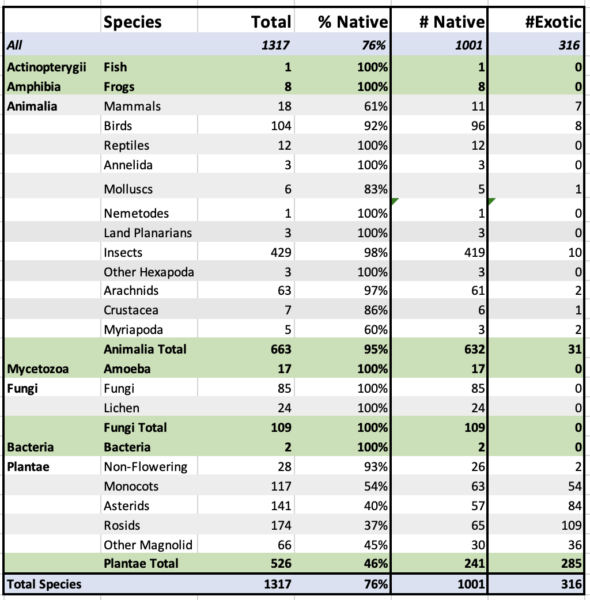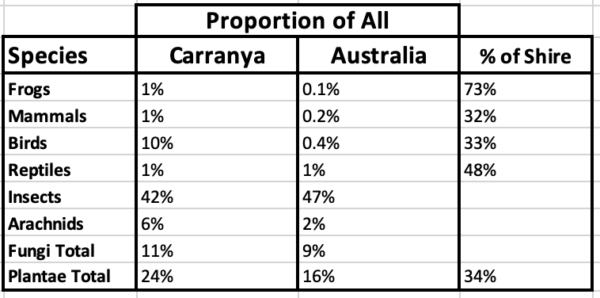Some Good News – Carranya Milestone
Our rehabilitation and revegetation efforts at Carranya over the past decade or so have just passed a major milestone – 1,000 indigenous species fully documented, most with images.

Details
As shown in the accompanying table, the biodiversity covers pretty well the full gamut of living things.
A couple of comments/caveats are in order:
- I have included all sightings, regardless of occurrence frequency – so, for example, a one-off visit from a pair of Sacred Kingfishers ranks the same as the daily occurrence of Australian Magpies
- With plants, I have included both those that were planted as part of the revegetation program (all correct as to EVC, etc), and those that regenerated naturally
- Most have been uploaded to iNaturalist and Atlas of Living Australia – it is a long, arduous task so I still have a number to get to.
 A proportional comparison with all of Australia (relative to total observed species) for each of the main groups is provided in the second table (‘Fungi’ includes Slime Moulds and Lichen). Proportionally, we are substantially over-represented in frogs, mammals and birds, about the same in reptiles, insects, and fungi, and slightly over-represented in fungi and plants.
A proportional comparison with all of Australia (relative to total observed species) for each of the main groups is provided in the second table (‘Fungi’ includes Slime Moulds and Lichen). Proportionally, we are substantially over-represented in frogs, mammals and birds, about the same in reptiles, insects, and fungi, and slightly over-represented in fungi and plants.
The right column shows the percentage of Carranya species compared to those that have been documented across the Shire. We have documented at least one third of all Shire species, about half the reptiles, and a high proportion of the frogs.
Not bad for a little patch of dirt covering just 7 Ha!
Work Done
We initially did little except clean up weeds and establish the wetland, while I worked up the courage to start what was a daunting task. Natural revegetation prospered, especially in the wetland. For example, the 2023 wetland survey documented 117 native plant species, of which 9 were there to start with, 40 were planted and 68 regenerated naturally (with considerable help from our ‘water-bird taxi’).
Most of the animals, and all of the fungi, etc, prospered as the vegetation became established. The number of fungi and slime moulds exploded when I cut down a largish number of Pinus radiata. A few animals found it unsuitable and moved on: Painted Button-Quail were seen early on, but disappeared as the bracken and other ground cover spread around; the Noisy Miner numbers dropped considerably and moved to just our western half as the pasture areas either disappeared or were only occasionally mown; I carried one White-footed Dunnart to safety when it sat stunned after being passed over by the slasher – I have not seen one since and suspect that Br’er Fox as the culprit.
With the exception of a few grasses (e.g. Couch, Sweet Vernal, Kykuyu) the initial large number of exotic species have either been defeated (e.g. Willows, Pittos, Phalaris) or are at the level of regular easy control efforts (e.g. Blackberry, Trefoil, Star Thistle). I can particularly recommend the Zen state that arises from rambling around with a machete lopping the heads and bodies off Star Thistles.
A big thanks to folks from Landcare and Spiffa, whose sage advice and help with revegetation as part of the GB2AS Biolink Project really got us started and provided the encouragement and the knowledge to continue.
It has been arduous, and mistakes often seemed to overshadow successes. Persistence is required to fix the mistakes and to hold the weeds at bay while the natives mature. We are now into the process of replacing the exotic grasses and grassland herbs with natives. I don’t want to discourage anyone, but this is a step up in difficulty from planting trees, bushes, etc.
Nevertheless, as I watch an initially vague and foggy vision expand into a glorious reality, the mistakes are fading away and the successes becoming events to celebrate. My goals now are to get it finished, have it covenanted, place a couple of benches at strategic locations, and spend balmy summer evenings sipping wine as the natural system busily goes about its business around me.
Beats television hands down!
– Greg Holland